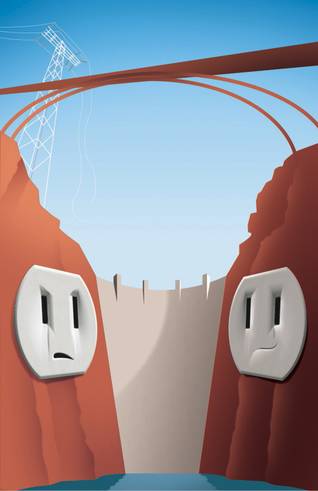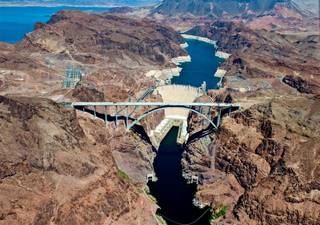Thursday, Feb. 17, 2011 | 2:01 a.m.
Boulder City
Home News
Sun archives
For more than a decade, the amount of water flowing through the Colorado River Basin has steadily dropped during one of the area’s worst droughts on record.
Its effects have been felt throughout Southern Nevada — water bills driven higher, Lake Mead National Recreation Area facilities closed and endangered species threatened within the lake’s fragile ecosystem.
And with every foot the river dips, Hoover Dam is further drained of its ability to generate electrical power.
Small populations such as Boulder City, descended in spirit from the workers who constructed the dam about 75 years ago, depended on it for their energy needs. But as the town grew and the dry spell took its toll on the dam’s productivity, the community was forced to look elsewhere and signed a contract more than 20 years ago with NV Energy for supplemental power.
Now, with the drought’s end nowhere in sight and the power company’s rates increased by more than 150 percent in the past two years, Boulder City plans to break ties with NV Energy and strike out on its own along with some smaller communities in search of cheaper energy.
The utility’s rate increases were permitted to pay for new power-generating projects.
The city — as part of the Silver State Energy Association, which includes Overton Power District, Lincoln County Power District, Southern Nevada Water Authority and the Colorado River Commission — will replace the power it purchased from NV Energy through other sources, such as the Western Area Power Administration.
Under this new agreement, the Silver State Energy Association will buy all power services for the city that don’t come from Hoover Dam.
The city should save $659,000 in the first year, utility Administrator Rory Dwyer said, and millions in the long term.
NV Energy provided less than 3 percent — 40 percent before rates were raised — of the power used in Boulder City in 2010. That power cost more than $750,000 — by comparison, the energy from Hoover Dam, a little more than 50 percent of the city’s supply, cost about $1.6 million.
Until 1987, Hoover Dam produced all of the city’s energy, purchased through the Colorado River Commission, but that year, the dam could no longer support the town’s budding population. NV Energy began providing the rest of Boulder City’s electricity, although as recently as 1997, the dam still delivered more than 80 percent of the city’s power.
Then, according to the U.S. Bureau of Reclamation, the effects of the drought set in during October 1999.
These days, Hoover Dam generates about half of Boulder City’s energy. Mesquite, Lincoln County and other rural communities have relied on the dam for most of their power for decades.
For a city such as Las Vegas, which gets about 3 percent of its power from Hoover Dam, the drought’s effect has been minimal, said George Caan, Colorado River Commission executive director.
But for Boulder City, “the impact … is much more dramatic,” he said. “The reductions in the dam’s capacity have a direct impact on rates for those areas. You’re always going to pay a higher rate than you would for hydropower.”
Dwyer recommended to the Boulder City Council this month that it end its contract with NV Energy and sign a new power-sharing agreement with the Energy Association for supplemental power. The higher rates from NV Energy had been passed on by Boulder City to its residents, amounting to almost 2 cents more per kilowatt-hour.
Over a month, that raised an average family’s bill from $115 to $154 for 2,000 kilowatt-hours. As the city terminates its NV Energy contract, Mayor Roger Tobler said it will explore if and how higher rates can be reduced.
Tobler said watching the city’s bills from NV Energy go up and passed on to residents in the midst of a recession has been “very frustrating.”
“That’s a hard thing to do, especially in this economy,” he said of absorbing the rate increases. “We had no control. We never enjoyed raising rates ... This (new purchase agreement) was definitely the right thing for the city.”
The council unanimously approved Dwyer’s recommendation. The city and NV Energy settled their contract dispute in December, Dwyer said, and established new terms that gave Boulder City until Feb. 28 to notify the utility the contract would be axed, effective June 1.
When NV Energy escalated its energy and capacity rates in October 2009, it provided more than 40 percent of the city’s power. Dwyer then started coordinating with the Colorado River Commission and Silver State Energy Association to purchase the rest of the city’s power from other sources.
Those purchases account for 47 percent of Boulder City’s energy.
At the moment, NV Energy still supplies that small sliver — less than 3 percent — but it’s a crucial component, as it covers day-to-day surges in the city grid.
Why do NV Energy’s prices go up? Dwyer pointed out that, as a company that provides public utilities, it has a contractual “right to a rate of return.”
Which means if it has a big project on the books, such the expected $682 million the company will spend on construction at the Harry Allen Generating Station this year, those costs are passed on to customers.
Future investments, such as the ONLine that would connect NV Energy’s Southern and Northern Nevada areas to the tune of $510 million, would have likely added to the bills in Boulder City, Dwyer said.



Join the Discussion:
Check this out for a full explanation of our conversion to the LiveFyre commenting system and instructions on how to sign up for an account.
Full comments policy